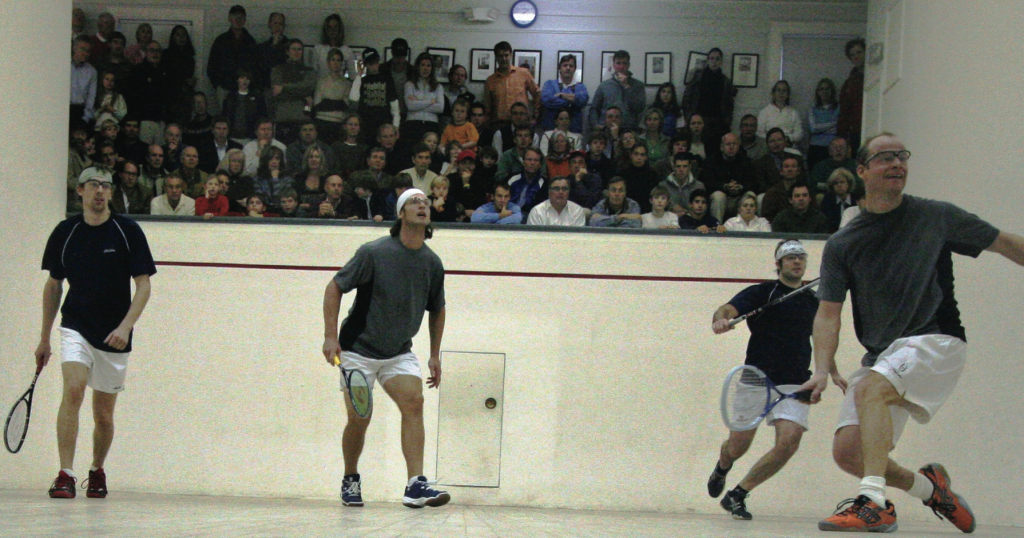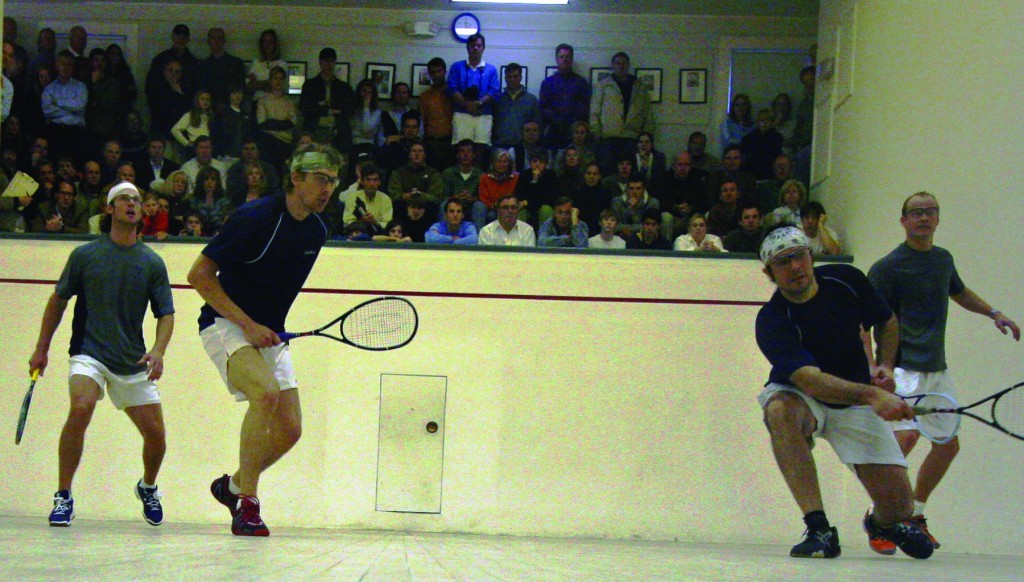
By James Zug
It was a perfect storm. People adored the man. People really liked to play and watch squash doubles with the best. People wanted to help one of the urban squash programs. People enjoyed loitering around an old-school, cozy country club. And when those people were in one of the wealthiest nooks in the world, then something happened.
Bam.

It is called the Briggs Cup. It is named after Peter, the effervescent head pro at the Apawamis Club in Rye, NY. Briggs runs a very popular operation. Every spring at the national juniors, it is a game to guess how many kids hail from Apo and whether any other munchkin factory (Merion, Heights Casino, Philly Cricket) can top it. More than seventy high school and college squash team captaincies have been filled by one of his kids. Forbes magazine recently dubbed him “the Nick Bollettieri” of squash. Without the perma-tan, of course.
Briggs has loads of adult acolytes, too. He runs the country’s largest member-guest, (the Ned Morris, 18 years old, with fifty-odd teams this winter), as well as one of the most consistent pro women’s singles tournaments on the fixtures list (the Marsh, sponsor for the last twenty years, and this season’s richest WISPA tournament on the continent). Court time demand is so high that Apawamis is headed towards a refurbishing (Briggs occupies a comically small, windowless office) that will add a couple of singles and a second, badly-needed doubles court.
But Apawamis’ grandest show has become the Briggs. It is so monumental, so outsized that it crashes into the manicured shores of Greenwich and Rye only every two years. No one could handle it if it was annual. It blows in with three pro-am draws, 46 guys and 46 pros. It has a full 16-team main draw (and further qualies). It crosses two states and uses every doubles court in Westchester and Fairfield counties (except that intriguingly uber-private court at a home in Greenwich). It runs for five full, match-delayed days.
And the 2007 Briggs was also the most mondo tournament in the country. Ever. Almost half a million was raised this year. Total prize money was $150,000—cold, hard cash on the barrelhead.
All of it was private money, without any corporate sponsorship. More than a hundred people gave and gave well. The money was tax deductible because most of it went to CitySquash, $250,000 or so. That‘s two-hundred-fifty-grand. In other words, nearly half the Bronx-based program’s budget in a weekend. “CitySquash is enormously grateful,” said executive director Tim Wyant. “It is a spectacular event for squash and for our program. The money is incredible, and we got to spend a whole weekend with an engaged, energized community, talking about what we do and why we do it.”
The Briggs is known for creating the urban program/pro tournament tax nexus—it was the tournament, under the careful research of a team of lawyers led by hedge-fund guru Steve Mandel, that figured out the parameters of tax deductibility. The Briggs is also known for its squash. There is just one social event, a simple cocktail party on Thursday night. Simple that is if you think having 300 of your closest friends in for a drink. But that is it.
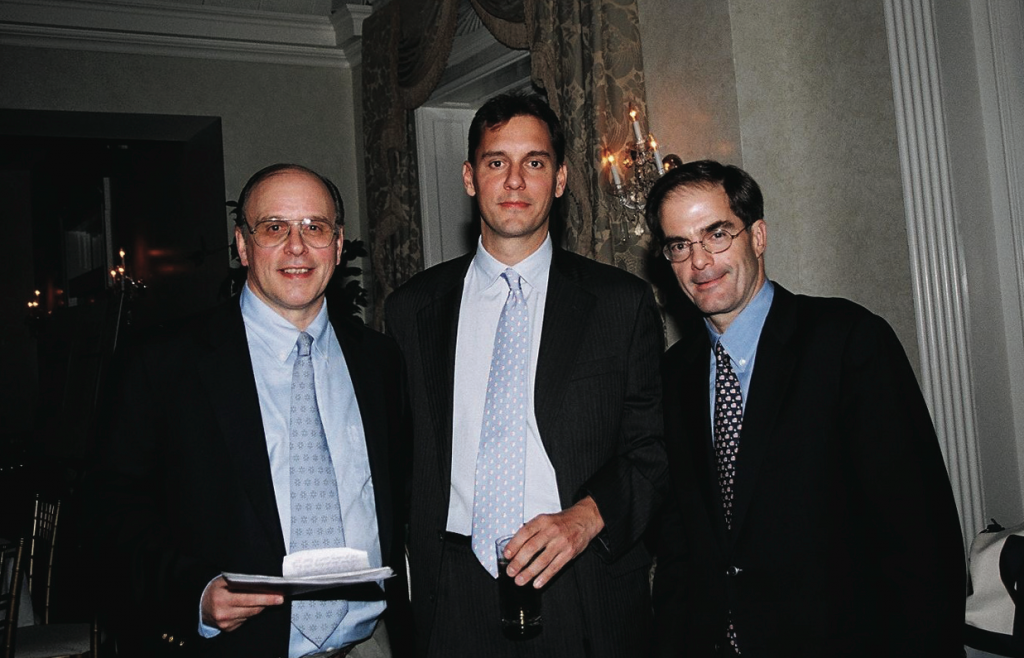
Most of the squash is actually that unique weather system known as the pro-am. “Briggsy gets the pros, we get the money,” says Mandel, and that simple formula was predicated upon the fact that the 46 ams in the Briggs Cup pro-am each tossed in at least one bag of sand to join up with a pro. They wanted their money’s worth. The pro cared about winning, since the total prize money from the three draws was $50,000. Since that money didn’t get split between two partners, it was in effect another five-star tournament.
There were big-name ams in the pro-ams. In the finals of the “Legends” draw, Paul Price and Mark Hayden, the head of Harrow racquets, overcame Gary Waite and New York squash rainmaker, Edward Minskoff, 3-1. This was spirited stuff, with Hayden diving agilely for short balls and sustaining a blow to the head. In the “Young A,” Joe Pentland and Billy Ullman, the man who helped secure Bear Stearns as sponsors of the Tournament of Champions, cruised through a series of 3-0 matches before running into Jeff Mulligan and lefty Brian Leonard. Pentland and Ullman took the match 3-1, with Ullman’s accurate cross-courts putting a sharpshooting Leonard on his heels. In the “Old A,” Chris Deratney and Simon Aldrich, the man with a golden volley on the squash or court tennis court, battled past Clive Leach and Robbie Berner after being down 0-2. Leach and Berner had fought off three match points in a second-round match against Tyler Millard and Marty Cannon and managed to survive, but couldn’t come up with such heroics a second time around when faced with a furious charge by Deratney and Aldrich.
Seven years ago when Gary Waite came up with the idea of splitting the pro doubles tour off from the singles tour, one rationale was that if he raised the prize money in the tournaments, PSA players would more or less defect to the ISDA. Having PSA giants would both raise the standard of the game and raise its profile.
His theory has come true and has come to haunt him personally. At the inaugural Briggs four years ago, Waite and Damien Mudge were a force of nature. They had not lost in 23 straight tournaments. Peter Briggs, in an effort to make the draw more balanced and ensure that the huge winner’s checks did not automatically flow into Waite and Mudge’s bank accounts, made them split up and play with different partners.
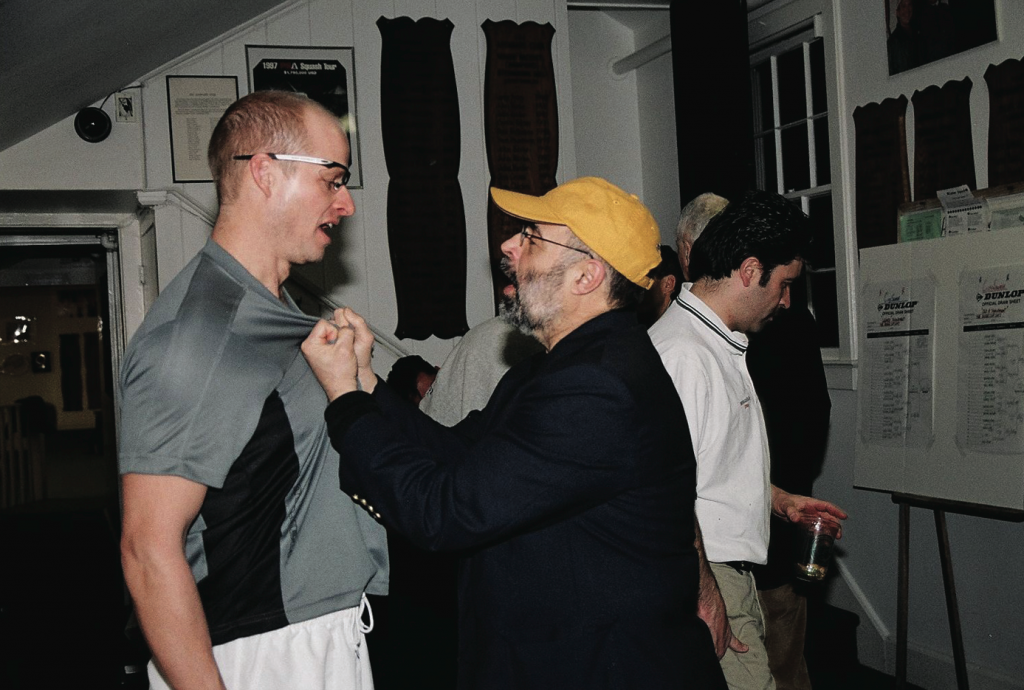
Not this year. The greatest doubles hurricane in history has officially been downgraded to a tropical depression. Coming into the 2006-07 season they had lost only seven times in 78 pro tournaments. Since October they had already lost three times. All three losses were to two thirty-something Aussies: Paul Price, who five years ago was World No. 4 in the PSA and had reached the final of the 2000 British Open, and Ben Gould, who topped out at 47 on the PSA Tour and after a spell at the Racquet and Tennis Club in New York is now the pro at the Sea Island Squash Club in Georgia.
Inexorably, the two tidal waves rumbled toward each other. Nothing could stop them—not Eric Vlcek who suffered a ruptured Achilles tendon in the opening round, not the reemergence of fabled Jamie Bentley and ageless jackrabbit Willie Hosey who reached the semis, and not Scott Butcher and Clive Leach who trailed 14-10 in the fifth against Chris Walker and Viktor Berg and then strung together five straight points to escape the quarters only to save five more match points before losing 15-12, 12-15, 16-15, 17-16 in a squally semis to Price and Gould.
Waite and Mudge managed to reach their anticipated rendezvous with Price and Gould in the most bizarre of manners. The rumor that flashed around in 1998 when Mudge sailed into New York was, “He hits the ball harder than Gary.” No one could believe it, but indeed, a fair amount of Waite and Mudge was simply picking up the trailer homes of opponents and tossing them across town.
But off-court activity had recently wounded both men. Waite had a sore left side after a skiing tumble two weeks before the Briggs. Mudge crashed in the waves off the Hamptons surfing last summer, hammering his right shoulder and reinjured it the week before in the University Club of New York’s O’Reilly pro-am when he awkwardly tumbled into the wall going for a ball. (“The wall didn’t give,” deadpans Mudge.) So instead of the typhoon, there was a soft breeze. They lobbed. This was 1970s doubles, with the old seamless, soft serves, high-arcing pattycakes, skid-boasts, paceless, angled volleys and a lot of quick-wristed flick drops. The shift of tempo unnerved everyone. (“At the end of the day, our ball-control is better than any other team,” says Mudge, “we can pull the ball around the four corners.”) Somehow they snuck through to the finals.
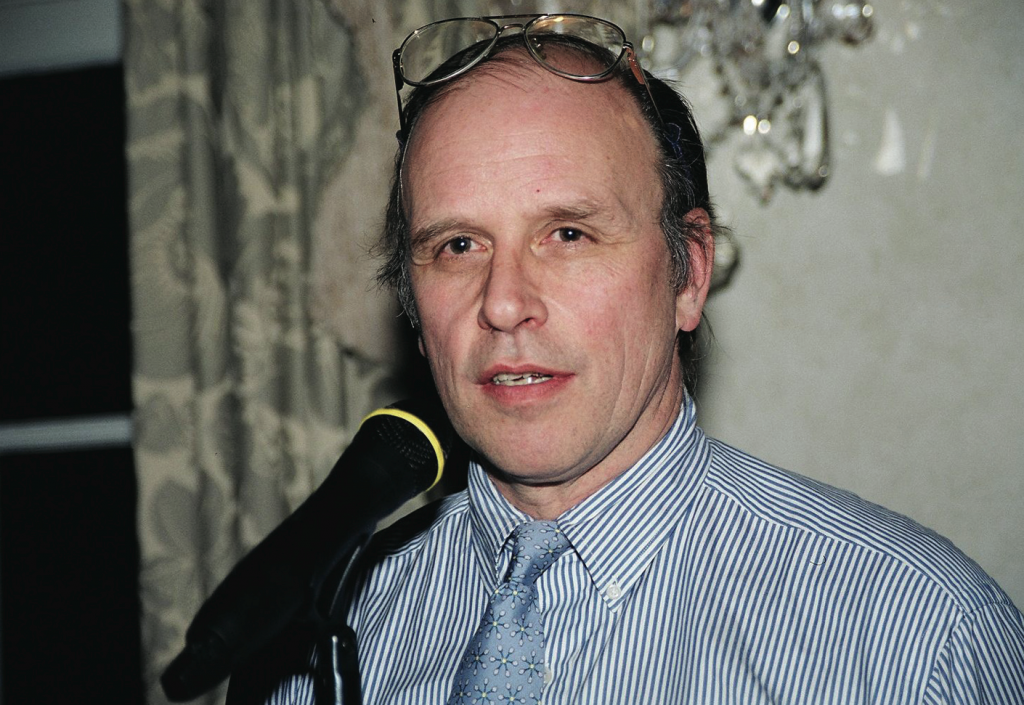
At first, the stunning lack of pace unnerved Price and Gould, too. They dropped the first game 15-12 and were forced to overtime in the second. They steadied themselves, refused to drop their season-long game plan (hit everything to Waite), took the third and were up 13-9 in the fourth when a last-ditch comeback by Waite and Mudge fell short at 15-13. Price pockets more than fifteen grand and his fourth in a row over the fallen kings.
Wither Waite and Mudge? Their injuries require rest and therapy, not surgery and everyone expects them in time to recover their accustomed No. 1 ranking, or at least win as much as they lose to Price and Gould. The reason for this belief is really not their skills or experience, but their competitiveness. Both men, especially Waite, are notoriously driven to win.
And that is the core of organized squash. One of the loveliest moments of the Briggs Cup was when Freddy Hernandez of CitySquash addressed the Thursday night cocktail crowd. Introduced by Tim Wyant as the number two player on the varsity ladder at Canterbury, his new prep school, Hernandez recounted his three- and-a-half-year, life-changing journey with CitySquash and then told about his new life at Canterbury. He spoke about his B average and how he is president of the freshman class. He added, after a pause that Waite and Mudge would most certainly understand, “and Tim got it wrong. I’m number one on the team.”
